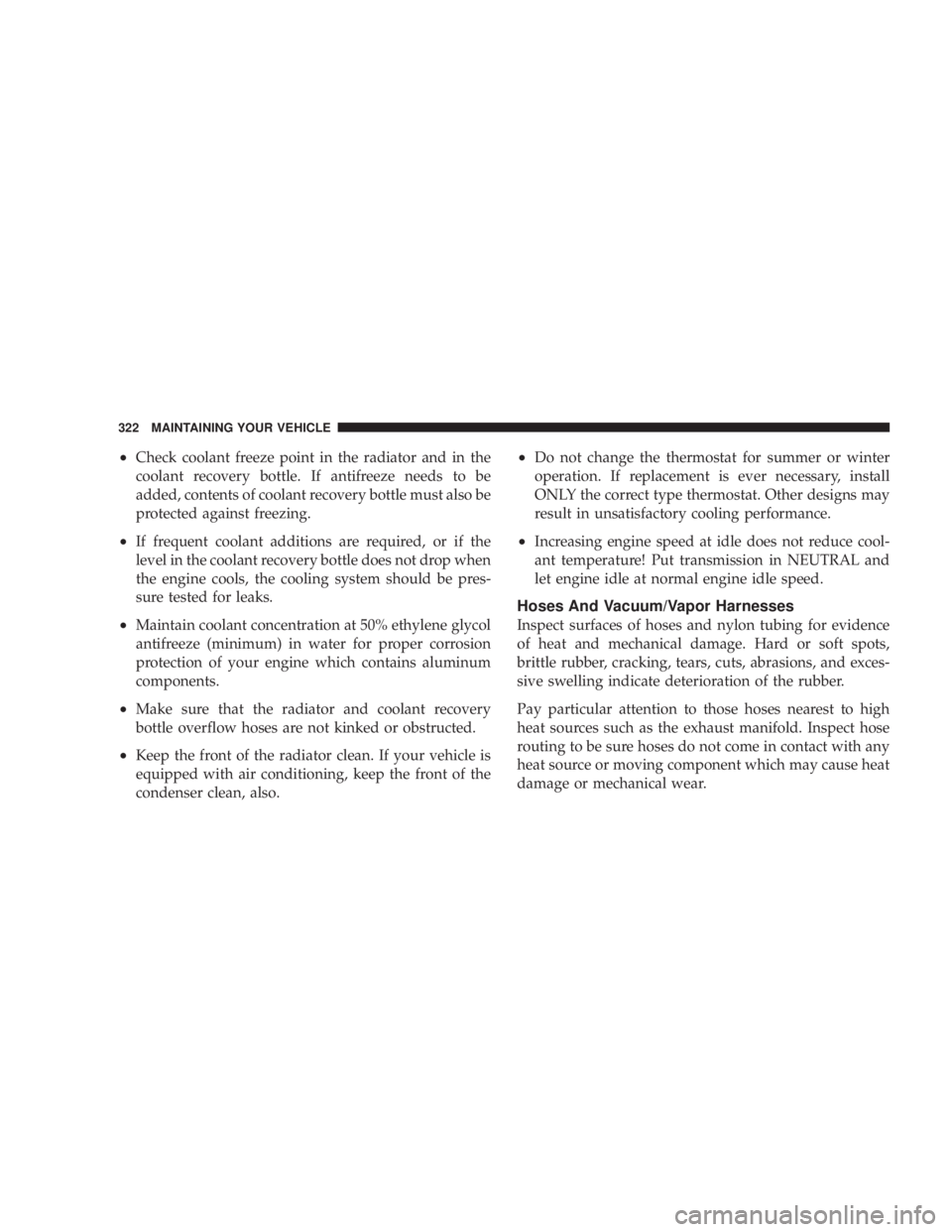Page 281 of 397

IF YOUR ENGINE OVERHEATS
In any of the following situations, you can reduce the
potential for overheating by taking the appropriate ac-
tion.
² On the highways Ð Slow down.
² In city traffic Ð While stopped, put transaxle in
neutral, but do not increase engine idle speed.
NOTE: There are steps that you can take to slow down
an impending overheat condition. If your air conditioner
is on, turn it off. The air conditioning system adds heat to
the engine cooling system and turning off the A/C
removes this heat. You can also turn the Temperature
control to maximum heat, the Mode control to floor, and
the fan control to High. This allows the heater core to act
as a supplement to the radiator and aids in removing heat
from the engine cooling system. CAUTION!Driving with a hot cooling system could damage
your vehicle. If temperature gauge reads ªHº, pull
over and stop the vehicle. Idle the vehicle with the
air conditioner turned off until the pointer drops
back into the normal range. If the pointer remains on
the ªHº, turn the engine off immediately, and call for
service. WHAT TO DO IN EMERGENCIES 281
6
Page 313 of 397

WARNING!² Use only refrigerants approved by this manufac-
turer for your air conditioning system. Some un-
approved refrigerants are flammable and can ex-
plode, injuring you. Other unapproved
refrigerants can cause the system to fail, requiring
costly repairs.
² Never add air conditioning refrigerant to correct a
non-cooling problem unless pressure gauges are
connected to the system by a certified technician.
Lack of cooling could be due to a restriction and
adding refrigerant may cause a dangerous pres-
sure rise and you could be injured.
Refrigerant Recovery And Recycling
The air conditioning system of your vehicle contains
R-134a, a refrigerant that does not deplete the ozone layer
in the upper atmosphere. The manufacturer recommends that air conditioning service be done by facilities using
refrigerant recycling and recovery equipment that meets
SAE standard J1991.
A/C Air Filter
The filter access door is located under the instrument
panel on the passenger side. To replace the filter slide the
lock toward the rear of the vehicle (unlock position).
Remove the access door and pull the filter downward.
When installing a new filter, ensure its proper orienta-
tion. Align the black arrow on the bottom of the filter
frame with the direction of airflow (away from the
blower motor and towards the center of the car).
Refer to the ªMaintenance Schedulesº section of this
manual for the recommended air conditioning filter
replacement intervals. MAINTAINING YOUR VEHICLE 313
7
Page 322 of 397

² Check coolant freeze point in the radiator and in the
coolant recovery bottle. If antifreeze needs to be
added, contents of coolant recovery bottle must also be
protected against freezing.
² If frequent coolant additions are required, or if the
level in the coolant recovery bottle does not drop when
the engine cools, the cooling system should be pres-
sure tested for leaks.
² Maintain coolant concentration at 50% ethylene glycol
antifreeze (minimum) in water for proper corrosion
protection of your engine which contains aluminum
components.
² Make sure that the radiator and coolant recovery
bottle overflow hoses are not kinked or obstructed.
² Keep the front of the radiator clean. If your vehicle is
equipped with air conditioning, keep the front of the
condenser clean, also. ² Do not change the thermostat for summer or winter
operation. If replacement is ever necessary, install
ONLY the correct type thermostat. Other designs may
result in unsatisfactory cooling performance.
² Increasing engine speed at idle does not reduce cool-
ant temperature! Put transmission in NEUTRAL and
let engine idle at normal engine idle speed.
Hoses And Vacuum/Vapor Harnesses
Inspect surfaces of hoses and nylon tubing for evidence
of heat and mechanical damage. Hard or soft spots,
brittle rubber, cracking, tears, cuts, abrasions, and exces-
sive swelling indicate deterioration of the rubber.
Pay particular attention to those hoses nearest to high
heat sources such as the exhaust manifold. Inspect hose
routing to be sure hoses do not come in contact with any
heat source or moving component which may cause heat
damage or mechanical wear.322 MAINTAINING YOUR VEHICLE
Page 337 of 397

The Heated Mirrors, Lower Instrument Panel Power
Outlet and Removable Floor Console, when in the front
position are fused with self resetting fuses that are only
serviceable by an authorized dealer. The power seats are
fused by a 30 Amp circuit breaker located under the
driver's seat. The Power Windows are fused by a 25 Amp
circuit breaker located under the instrument panel near
the steering column. If you experience temporary or
permanent loss of these systems see your authorized
dealer for service. VEHICLE STORAGE
If you are leaving your vehicle dormant for more than 21
days you may want to take steps to protect your battery.
You may:
² Remove the 20 Amp mini fuse in the Integrated Power
Module labeled Ignition-Off Draw (IOD).
² Or, disconnect the negative cable from the battery.
² Anytime you store your vehicle, or keep it out of
service (i.e. vacation) for two weeks or more, run the
air conditioning system at idle for about five minutes
in the fresh air and high blower setting. This will
insure adequate system lubrication to minimize the
possibility of compressor damage when the system is
started again. MAINTAINING YOUR VEHICLE 337
7
Page 352 of 397
Miles 3, 000 6, 000 9, 000 12, 000 15, 000 18, 000
(Kilometers) (5 000 ) (10 000 ) (14 000) (19 000) (24 000) (29 000)
Change engine oil and engine oil filter. XXXXX X
Inspect the brake linings. X X
Inspect the engine air cleaner filter, replace if
necessary. * XXXX X
Replace the engine air cleaner filter. *X
Inspect and adjust the power steering pump
belt tension on 2.4 liter engines. X
Inspect the generator belt on 2.4 liter engines,
replace if necessary. X
Change the All Wheel Drive (AWD) power
transfer unit fluid. (See note at the end of this
chart) X
Replace the air conditioning filter. X 352 SCHEDULE ªBº
8 M
A
I
N
T
E
N
A
N
C
E
S
C
H
E
D
U
L
E
S
Page 354 of 397
Miles 21, 000 24, 000 27, 000 30, 000 33, 000 36, 000
(Kilometers) (34 000) (38 000) (43 000) (48 000) (53 000) (58 000)
Change the All Wheel Drive (AWD) overrun-
ning clutch and rear carrier fluid. (See the note
at the end of this chart) X
Replace the air conditioning filter. X X 354 SCHEDULE ªBº
8 M
A
I
N
T
E
N
A
N
C
E
S
C
H
E
D
U
L
E
S
Page 355 of 397
Miles 39, 000 42, 000 45, 000 48, 000 51, 000 54, 000
(Kilometers) (62 000) (67 000) (72 000) (77 000) (82 000) (86 000)
Change engine oil and engine oil filter. XXXXX X
Inspect the brake linings. X X
Inspect the engine air cleaner filter, replace if
necessary. * XX XX X
Replace the engine air cleaner filter. *X
Inspect and adjust the power steering pump
belt tension on 2.4 liter engines. X
Inspect the generator belt on 2.4 liter engines,
replace if necessary. X
Change the All Wheel Drive power transfer
unit fluid. (See the note at the end of this
chart.) X
Change the All Wheel Drive (AWD) overrun-
ning clutch and rear carrier fluid. (See note at
the end of this chart) X
Replace the air conditioning filter. X SCHEDULE ªBº 355
8 M
A
I
N
T
E
N
A
N
C
E
S
C
H
E
D
U
L
E
S
Page 357 of 397
Miles 57, 000 60, 000 63, 000 66, 000 69, 000 72, 000
(Kilometers) (91 000) (96 000) (101 000) (106 000) (110 000) (115 000)
Inspect the serpentine drive belt on 3.3 liter
and 3.8 liter engines, replace if necessary. X
Change the automatic transaxle fluid and fil-
ter. X
Change the All Wheel Drive (AWD) power
transfer unit fluid. (See note at the end of this
chart) X
Change the All Wheel Drive (AWD) overrun-
ning clutch and rear carrier fluid. (See note at
the end of this chart) X
Replace the air conditioning filter. X X SCHEDULE ªBº 357
8 M
A
I
N
T
E
N
A
N
C
E
S
C
H
E
D
U
L
E
S